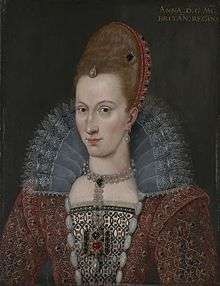Great H of Scotland
The Great 'H' of Scotland was a jewel belonging to Mary, Queen of Scots. It was broken up in 1604 and made into the Mirror of Great Britain for James VI and I.

Mary Queen of Scots
The "H" was a pendant known as the 'H' because of its form, and was also called the 'Great Harry'. It first appears listed in an inventory of jewels belonging to Mary Queen of Scots made in France in the 1550s, as a French crown jewel, and two of its stones were mentioned, a large facetted lozenge diamond which formed the bar of the 'H' and hanging below this a large cabochon ruby. Later Scottish inventories also mention the great diamond and pendant ruby, and a small gold chain and other diamonds.[1] Mary was allowed to keep this jewel after the death of her husband Francis II of France and brought it to Scotland. The jewel, as its shape suggests, may have been a present from Henri II of France. Mary hoped to add it to the crown jewels of Scotland in memory of her reign.[2] Her father, James V of Scotland owned a different 'H' jewel, a hat badge with a ruby and two figures with the letter 'H' possibly a gift from Henry VIII of England.[3]
Regent Moray, Regent Morton, and the Earl of Arran
After Mary's abdication, her half-brother Regent Moray brought the jewel to England hoping to sell it, and his agent Nicolas Elphinstone sold Mary's pearls to Queen Elizabeth. After Regent Moray was assassinated by James Hamilton of Bothwellhaugh, his widow Agnes Keith retained the "H" for several years, despite requests from Mary Queen of Scots and Regent Morton. Eventually she returned it to Morton.[4]
In 1585 James Stewart, Earl of Arran was said to have embarked on a boat at Ayr carrying the royal jewels including 'Kingis Eitche', but was forced to give up the jewels to George Home.[5] The jewels recovered from the Earl of Arran and his wife Elizabeth Stewart, Lady Lovat including the "H" were formally returned to the treasurer of Scotland, Robert Melville on 23 February 1586.[6] The governor of Dunbarton Castle, William Stewart of Caverston, had negotiated the recovery of the jewels, and delivered the "H" into the "king's own hands".[7]
James VI and I
James VI gave the 'H' to Anne of Denmark to wear. However, in September 1594 he pawned it with the jeweller Thomas Foulis for £12,000, when it was noted that the large diamond was in the centre "the middis of the same H". James VI needed the money for his military expedition to the north of Scotland against the Earl of Huntly and the Earl of Erroll.[8] An English diplomat George Nicolson heard that Foulis had a breakdown in January 1598 when James reclaimed the jewel without payment.[9] Nicolson also heard that Anne of Denmark had offered the jewel to her friend Elizabeth, Countess of Erroll as recompense for the demolition of Old Slains Castle by James VI in 1594.[10]
In 1604 the jewel was dismantled and the large diamond was used in the new Mirror of Great Britain which James wore as a hat badge.[11]
The remaining components of the Great 'H' were mentioned in 1606 when George Home, Earl of Dunbar, gave up the office of Master of the Wardrobe and delivered to James Hay, master of the robes, the rest of the jewel including the chain and ruby.[12]
Other royal "H" jewels
King James gave another old jewel in the form of an 'H' from the royal collection to Frances Howard, Duchess of Richmond in March 1623. This jewel had two pointed diamonds, six table cut diamonds, and three pendant pearls, and was kept in a crimson box in the secret jewel house of the Tower of London.[13] This was probably the jewel listed in the inventory of Henry VIII in a coffer of the Queen's jewels in the Tower. King James gave it of Anna of Denmark in 1607, and also she had another "H" jewel with rubies and diamonds.[14]
References
- Thomas Thomson, Collection of Inventories (Edinburgh, 1815), pp. 196-7, 200, 265, 291, 307, 318.
- Joseph Robertson, Inventaires de la Royne Descosse (Edinburgh, 1863), p. 93.
- Thomas Thomson, Collection of Inventories (Edinburgh, 1815), p. 65.
- Joseph Robertson, Inventaires de la Royne Descosse (Edinburgh, 1863), pp. cxxxi-cxxxii: HMC 6th Report & Appendix: Lord Moray (London, 1877), p. 658.
- John W. Mackenzie, A Chronicle of the Kings of Scotland (Edinburgh, 1830), p. 139.
- Thomas Thomson, Collection of Inventories (Edinburgh, 1815), pp. 318-9.
- David Masson, Register of the Privy Council of Scotland, 1585–1592, vol. 4 (Edinburgh, 1881), p. 41.
- Register of the Privy Council, vol. 5 (Edinburgh, 1882), p. 172-3.
- Register of the Privy Council, vol. 5 (Edinburgh, 1882), pp. 433-4.
- Border Papers, vol. 2 (1894), p. 504.
- John Nichols, The progresses, processions, and magnificent festivities, of King James the First, vol. 2 (London, 1828), pp. 46-7: Ancient Kalendars and Inventories of the Treasury of the Exchequer, vol. 2 (London, 1836), p. 305: Joseph Robertson, Inventaires (Edinburgh, 1863), p. cxxxviii.
- Thomas Thomson, Collection of Inventories (Edinburgh, 1815), p. 329.
- CSP Domestic James I:1619-1623, vol. 3, p. 520, TNA SP 14/139 f.114.
- David Starkey, The Inventory of King Henry VIII, vol. 1 (London, 1998), p. 78 no. 2640: Diana Scarisbrick, 'Anne of Denmark's Jewellery Inventory', Archaeologia, 109 (Torquay, 1991), pp. 208-9, 211: Francis Palgrave, Antient Kalendars of the Exchequer, vol. 3 (London, 1836), p. 307.